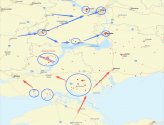Unlike the Antonovsky bridge that has a more reinforced structure, these blocks that you are proposing to bequeath to the crossing system would not require so many attacks to disable, in addition, they are in the range of Ukrainian artillery, the biggest example of this is the FIRMS data:This is why there is redundancy to these bridges, I suggested 10 with 5 in reserve, but you phrase this suggestion as through Ukrainian efforts has no cost to them as well. The Ukrainians are 40km away from most of these positions and are out of reach of conventional artillery, this leaves them with guided systems, which can be counterattacked. If one of those rockets hits a section it can be restored quickly, just float another one in its place, rely on the other 9 until it's fixed.

Look at the distance from the Russian GLOCs that Ukraine is attacking. Incidentally, these are the areas that the Russian MoD uses to describe reports of various Himars intercepted, that is, range is not an issue for Ukraine. It was never a problem for Ukraine because since they received the Himars, they have been attacking Russian munitions depots in Kherson ever since, it would simply be to redirect targets to the Dnieper which would be even less ranged.
By any chance, are the Russians managing to neutralize the launchers being used against Kherson? I have seen claims of Himars losses by the Russian MoD, but no visual confirmation capable of making this verification, because they are videos and photos with such a bad quality that you can't even say that it was a Himars system, besides, they still continue to use the Himars in Kherson attacking the Russian GLOCs in the rear.Ukrainians have to consider that attacking the bridge exposes their launchers and their aircraft, what if the launcher gets counterstriked?
This is quite possible, but the use of the aircraft would only take place in specific cases, this case of withdrawal is quite possible or in the case of a logistical reinforcement in the crossing to reinforce the fronts of the right bank, which would in reality be losing aircraft, but I doubt they would do a suicide mission, it would be a job with drones and artillery too, not only does it depend on aircraft, the biggest example is the reality itself in Kherson where Ukraine relies heavily on accurate artillery to attack ammunition depots in the rear, on the bridges of the Dnieper among other places of logistical military use.what if aircraft get shot down?
A caster can be deployed in less than 3 minutes. Do you really want to make these comparisons?is it worth trying if the Russian can just drag another section withina dayhours?
Ukraine can disable all 10 if needed, as I said, neutralizing these structures would be even easier to neutralize the Antonovsky bridge, so in any army in the world you don't build these bridges when you're in enemy range, but you still ignore it.is it worth disabling 7 of the 10 if the Russian can still continue using the other 3?
And the transport of it? Wouldn't there be a logistical effort to assemble and fit the structures? Can all this be done under the action of enemy artillery? Do you know why they don't build these structures when you're in enemy range?A missile is a rocket engine and a guidance system, a pontoon bridge section is welded steel plates with some hinges, who loses more when it comes to mutual destruction?
But that's exactly what I'm talking about. It will be applied like the Antonovsky Bridge was applied making it unusable, it would be even easier than the Antonovsky Bridge.But either way as an argumentative point its irrelevant because everything said about it also applies to the current Antonovsky bridge as well.
I never said that temporary bridges are useless. The fact is that creating them for the purpose of supplying the army on the other bank while still at the direct risk of enemy artillery is a good plan to want to wipe out your entire army on the other bank, leaving them trapped still within range artillery and now without logistical support in the crossings due to the neutralization of these hoisted bridges. Bridges are only built when such a condition is obtained by conquering the regions that prevent the enemy from carrying out observed fires in the selected places, here on the contrary, the Russians are only retreating day after day, losing these regions. Also, the Antonovsky bridge is already basically useless for logistical purpose, as I've previously posted the source claiming this I won't repost, but other members have already posted the Dnieper crossing with ferries.To consider potential temporary bridges useless and unworkable because of possible risk of neutralization is to also argue the Antonovsky bridge is useless, yet it was used and greatly enhanced Russian position on the west bank.
Want more examples?
Read it.
Here you said something right. After the construction of bridges, pontoon bridges continue to be used, supplementing them, but I have already said in what condition this is possible and under the action of enemy artillery it is simply wrong. So the Russian position on the right bank is untenable, but if you don't want to accept that fact, we agree to disagree. But you still haven't answered my previous questions.Even one pontoon bridge, in addition/place of current ferry would greatly enhance the current Russian position. If you accept this fact you also have to accept that there's considerable benefit to multiple redundant crossings.
I got tired of it.
